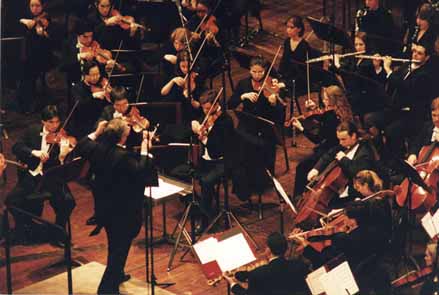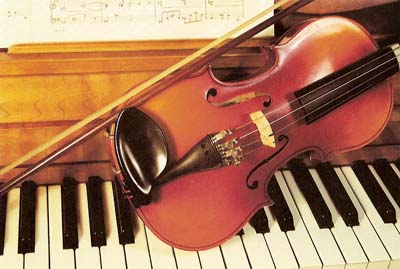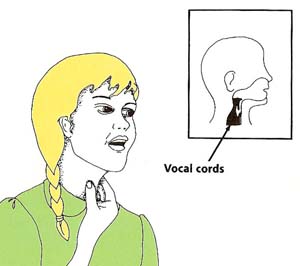SOUNDS INTERESTING: The Science of Acoustics - 4. Making Music

Figure 1. Symphony orchestra.

Figure 2. Piano and violin.

Figure 3. Vibrating column of air.

Figure 4. Experimenting with sounds.

Figure 5. Vocal cords.
Jazz, opera, rock, soul – music comes in an amazing variety of forms (see Figure 1). It is played in every country on earth, to relax, to rejoice, to dance, or to march by. But what is the difference between sounds that are musical and those that are not?
Music is a series of sounds arranged so that people – or some people, at least – enjoy them. The basic building blocks of musical sounds are notes. In these, the sound waves vibrate in a regular and repetitive way. A noise, on the other hand, is made up of sound waves that have no regular pattern.
Strums, Hums, and Drums
Music can be made in many different ways. Some instruments, like the guitar, have strings that are plucked. Others have strings that are stroked with a bow. Wind instruments, such as flutes, trumpets, and saxophones, are played by blowing into them. Others, including xylophones and drums, make musical sounds when they are struck.
All instruments have their own special sound by which they can be recognized. Even when the same note is played on two different instruments – a clarinet and a trombone, for example – we can tell them apart. The reason is that each instrument, as well as producing a basic note, also gives off a wide assortment of other, related notes at the same time. It is these accompanying sounds which, together with the basic note, create the unique sound quality, or TIMBRE, of each instrument.

Same Note, Different SoundYou will need:
What to do: Ask each musician to play (in turn) the same note – for example, middle C – on his or her instrument. After each note, asked the first blindfolded volunteer to say which instrument, from a list of possible choices, has just sounded. Repeat the test with other volunteers What are the results? Did any instruments prove especially hard to identify? Why do you think this should be?
Do the experiment again, but this time ask the musicians to sound the note in pairs. For example, a piano and a flute might play the same note together, or a clarinet and a guitar. In each case, the musicians should try to play at the same volume. Ask each volunteer to say which instruments are playing. How well do the volunteers score? Which instrument pairs do they have the most difficulty in identifying?
Taking it further: The best way to study the differences in sound produced by various musical instruments is with a microphone connected to a device called an oscilloscope. Perhaps a demonstration using this equipment could be set up in your school laboratory. An oscilloscope will show the shape of the sound waves picked up by a microphone. It also allows you to measure the frequency at which most of the sound is being given off. How does this differ from one instrument to another? How does the shape of the sound wave change if the note is played louder or softer?
Use the oscilloscope to look at the pattern of sound waves in your own voice. Try saying different words or vowel sounds. Compare your "voice patterns" with those of other people. Can you see any differences?
Compare the appearance of the sound wave of a noise, such as hands clapping, with that of the note from a tuning fork. |
The Sounds of Music
All string instruments have a set of stretched strings or wires (see Figure 2). These vibrate at different rates depending on their length and tightness. The vibration of a string causes the whole body of the instrument to vibrate. This results in a much louder sound. A violin and guitar have only a few strings, so the musician must hold down the strings in various positions to play all the possible notes of the instrument. A piano or harp, on the other hand, contains one or more strings for every note.
Blowing into a wind instrument, such as a flute, causes a column of air to vibrate. The length of this column determines the pitch of the note – the longer the column, the deeper the sound (see Figure 3). For example, if you cover just the top hole of a recorder, the note is high because the air can vibrate only as far as the next open hole. However, if you cover all the holes, the note is lower because the air can now vibrate throughout the whole length of the instrument. Some wind instruments, in order to produce very low notes, have such long tubes that they must be bent around several times. The coiled brass piping of a tuba, for instance, measures over twelve feet in length.
A percussion instrument, such as a xylophone or drum, works in the simplest possible way. Its playing surface is struck and caused to vibrate directly.

Playing ScienceYou will need:
What to do:
Cover all the holes on the recorder with your fingers. Blow gently into it and listen to the pitch of the sound it makes. Take a deep breath and blow into the recorder while you push it into a jug of water (see Figure 4). What happens to the pitch of the note? Take another breath and blow again while you pull the recorder out of the water. Can you explain what you hear?
Flatten the end of one straw and snip off the corners as shown in the diagram. Hold the cut end lightly between your lips and blow gently. What happens? Cut off half the straw. How does the sound change? Prepare the end of another straw in the same way. Take a deep breath and, as you blow into the straw, quickly snip off short sections from the end. With practice you may even be able to play a scale.
Fill the bottles with water to different heights. Tap each bottle gently in turn with a wooden spoon. What do you notice? Try to tune the bottles to some of the notes on a piano. Blow across the open top of the bottles. Compare these sounds with those produced by tapping.
Ask an adult to show you the inside of a piano. What happens when one of the keys is pressed? How is the sound produced? What happens when the various pedals o the instrument are pushed down? How many strings are there for each key on the keyboard? Why should this be? Try holding all but one of the strings while someone presses the corresponding key. How does this affect the sound? |
Good Listening
Sounds inside a room travel not just directly to your ears, but also after bouncing off the walls, floor, and ceiling. If these surfaces are hard and bare – as they often are in a church, for example – any sounds you hear may seem harsh and confused. If you ever moved from your house you may have noticed how much the rooms echo when they are empty of furniture, curtains, and carpets.
In the case of a concert hall, the quality of sound reaching the audience's ears is all-important. For this reason, great care has to be taken in designing the shape of the room and the materials that cover the walls, ceiling, and floor.

A Model Concert HallYou will need:
What to do: Place the tape recorder on a table against one wall of the room. Turn on the recorder so that it plays at a fairly high volume. Stand at the back of the room and listen to the sound. How would you describe it? Is it harsh or mellow? Why should this be?
Bring some items such as a rug, a few padded chairs, and some sheets into the room. Ask an adult to help you hang the sheets against one or two of the walls. Play the recorded music again. Has the sound changed? In what way? Experiment with other arrangements of wall and floor coverings and items about the room. How is the quality of sound affected? Try to achieve the best possible sound – not too harsh and not too muffled. Does the sound quality vary from one part of the room to another? |
Synthetic Sound
A synthesizer can produce the sound of a church organ, of breaking glass, of a trumpet, or of weird sounds no human ear has heard before. To synthesize means to put together. So a synthesizer is an instrument that can build complex sounds from simpler ones. It uses a computer to create and store sounds electronically. These sounds can then be called up and played – usually by pressing the keys of a keyboard that is connected to the synthesizer.
An extension of the synthesizer is the "sampler." This can record real sounds, such as those of a drum or an electric guitar, and convert them into a series of numbers which are stored by a computer. Samplers are used in recording studios to capture the sounds made by separate instruments and singers. Recordings of a number of performances are made and, from these, the best parts are put together and improved electronically. Strange as it seems, none of today's hit records were ever played as you hear them.
The Human Voice
If you touch the front of your neck while you say something, you will be able to feel your throat vibrating. This is because you have two flaps of skin inside your throat called vocal cords (see Figure 5).
When you speak or sing, air from your lungs is forced over the vocal cords causing them to vibrate. In turn, this makes the air in your throat and mouth vibrate at the same rate. Muscles in the throat stretch the vocal cords tighter to make high sounds and relax them to make deeper tones. Women generally have higher voices than men because their vocal cords are shorter.
The basic sound from the vocal cords can be altered a great deal through movements of the mouth, tongue, and lips. In this way, we can produce all of the many variations of found in human languages.

Blow Your Own Horn
Lightly touch your neck while you hum a note. Now hum a higher note, followed by a lower note. Can you feel any change? If so, can you explain what may have moved? As you hum, press gently several times against your neck. Does the sound change? Why should that be? Open your mouth wide and make a sound without moving your mouth. This is the basic sound produced by your vocal cords. Now try moving your mouth, tongue, and lips in different ways. Listen to the variety of sounds that come out. |
 |


